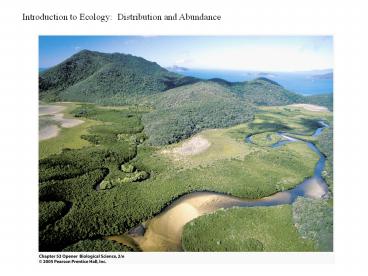Biological%20Science%202/e - PowerPoint PPT Presentation
Title:
Biological%20Science%202/e
Description:
Biological Science 2e – PowerPoint PPT presentation
Number of Views:48
Avg rating:3.0/5.0
Title: Biological%20Science%202/e
1
Introduction to Ecology Distribution and
Abundance
2
Ecology can be studied at different hierarchical
levels.
3
Abiotic factors influence distribution and
abundance. Some species cant live where it is
too cold.
4
Abiotic factors influence distribution and
abundance. Some species cant live where it is
too warm.
Boreal forest species.
5
Abiotic factors influence distribution and
abundance. Some species cant live where it is
too dry.
This species of kangaroo lives in Eastern
Australia, which is relatively moist year round.
6
Species introduced by humans may rapidly expand
their range
2005
(Introduced into SE Brazil 1960s.)
7
Species abundance and distribution are
also affected by biotic interactions.
8
Species Interactions
- Affect distribution and abundance
- Create evolutionary pressures
Interactions include competition,
consumption, mutualism
9
Interspecific competition can take various forms.
10
Every species has its own niche, or
multidimensional resource space (habitat
requirements, food, etc).
Left to right Cape May, Yellow-rumped,
Black-throated Green, Blackburnian, and
Bay-breasted Warblers.
For example, MacArthur found that different
warbler species feed in different parts of the
tree.
11
Interspecific competition occurs where niches
overlap
12
Competition can shape patterns of species
co-existence
Competitive exclusion principle Two species
cannot co-exist if the niche is the same but one
species is a better competitor than the
other. Think about the Great American
Interchange.
13
A graphical demonstration of asymmetric
competition.
14
Complete niche overlap with asymmetric
competition.
15
Gauses famous experiment.
- The purple species excludes the green one because
- Their niches overlap and
- The purple is a stronger competitor.
16
(No Transcript)
17
Rocky intertidal famous for competition.
18
(No Transcript)
19
(No Transcript)
20
Chthamalus tolerates dessication better than
Balanus does. Balanus a better competitor
drives Chthamalus out below MH neap.
21
Abiotic factors often limit expansion into more
difficult habitats Competition often limits
expansion into more desirable habitats.
Grows well when planted outside of range.
Pin oak found on soils with poor aeration.
22
We have just seen that competition can have
ecological effects -- in the dist. and abundance
of orgs. Competition is also thought to have
evolutionary effects, through its actions as a
selective agent. Character displacement
evolution towards niche divergence as a response
to competition.
23
(No Transcript)
24
Character Displacement in Darwins
finches? Experimental evidence difficult!
25
Beak depths of G. fortis and G. fuliginosa differ
when they are alone on an island, compared to
when they have competitors.
26
Consumption also influences the abundance and
distribution of organisms, and generates
evolutionary arms-races. Includes Herbivory,
Predation, Parasitism
27
Hare-lynx population cycles famous example of
predator- prey relationship affecting abundance
of animals.
28
(No Transcript)
29
Predation by starfish regulates animal diversity
in the rocky intertidal zone.
30
Predation creates obvious evolutionary pressures.
31
Size can provide protection from predation.
32
Mimicry can provide protection from predation.
33
Predator satiation can provide protection from
predation.
Periodical cicadas emerge at densities of
100,000/acre every 13 or 17 years (depending on
the species)
34
Plants produce defensive compounds to deter
herbivores.
Plant-based medicines are generally derived from
such defensive compounds e.g., aspirin,
digitalis, morphine.
35
Some organisms have inducible, as well as
constitutive defenses.
36
Its an arms race out there defense may protect
against beavers, but there are insect
specialists that can detoxify the compounds.
(when put on anthill.)
37
Parasites are a ubiquitous fact of life for
animal species.
Ascaris lumbricoides (roundworm) infects 25 of
worlds people.
How many species parasitize humans? (Not counting
viruses or bacteria) 342 species of worms,
mostly nematodes and flatworms 70 species of
protozoa such as amoebas
38
Hosts and parasites are in a continual
evolutionary arms race -- lets look at one
example.
39
(No Transcript)
40
Mutualism, like competition and consumption, has
both ecological and evolutionary impacts.
41
Dinoflagellate zooxanthellae live symbiotically
inside of coral polyps (Phylum Cnidaria).
They also live in some nudibranchs. (Phylum
Gastropoda). Probably the nudibranchs eat the
cnidarians to get the zooxanthellae.
http//www.seaslugforum.net/factsheet.cfm?basesol
arpow
42
You already know about some other important
mutualistic relationships.
mycorrhizae
plant pollinator
43
Humans have a mutualistic relationship with
honeyguides.
Indicator indicator eats bee larvae,
pupae. Guides human to hive so that human will
break it up.
44
See the summary of species interactions in your
text.
45
Community Structure I Do communities have a
tightly prescribed organization and composition
that is predictable? Or, are they merely a loose
assemblage of species?
Good question will take up in Ecology or Woody
Plants.
46
Community Structure II Is there a relationship
between biodiversity and the productivity and
stability of the community? Important question
for agriculture, conservation. To answer this
question, must define Biodiversity Productivity
Stability
47
Use both number and evenness of species
abundances in an index of diversity.
48
Productivity is measured by Net Primary
Production (NPP) Carbon fixed by photosynthesis
(GPP) Minus the carbon lost by respiration How
much biomass is gained per unit of time a
rate. Now measured from space.
http//www.geosuccess.net/geosuccess/relay.do?dis
patchNPP_info
49
In grasslands, diverse plots have higher
productivity.
50
Why would diverse communities have higher
productivity? Interspecific competition less
intense than intraspecific. Pest populations may
be reduced.
A challenge for modern agriculture.
51
Two indicators of stability Resistance How
much does a disturbance affect a community? Resil
ience How quickly does a community
recover following a disturbance?
52
(No Transcript)
53
(No Transcript)
54
Diverse communities are resilient example
Fires and a cyclone caused deforestation on Samoa
in 90s. Fruit bats required to re-establish
forest. Some bat species declined greatly, but
at least one did not.
55
If diversity brings resilience, thats another
reason why we should try to maintain biodiversity
in natural systems.
Sri Lanka
Mediterranean Basin
West Africa
Cape Floristic Region

